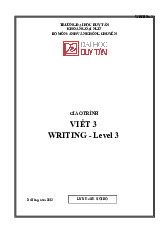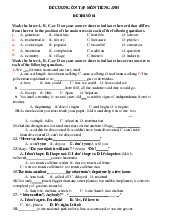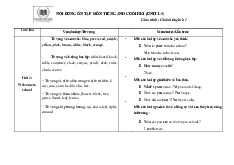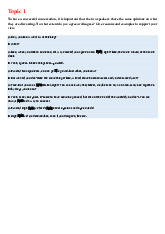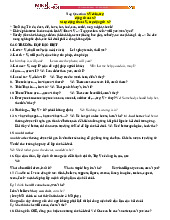






Preview text:
lOMoAR cPSD| 46836766
1. What is the subject matter of lexicology? Answers:
The subject matter of lexicology is the word, its structure, formation, meaning, history, phraseology, lexicography,
and regional varieties of the words. In a broad sense, lexicology can be said to include five essential branches: -
Word structure and formation investigate all the problems concerning the structure of the word and the way it is formed. -
Semantics (or semasiology): focuses on the meaning of the word chiefly lexical meaning, discusses the types
of meaning, the change and development of meaning, the grouping of words and ... -
Phraseology: goes into set (fixed) expressions which are reproduced in speech as ready-made units. There
may be standardized word combinations, idioms, proverbs etc. from only two- word phrases to very long sayings. In
English, there are such set expressions as “Good heavens, diamond cuts diamond, no pains no gains” -
Etymology: refers to the history, the origin of words. Etymologists divide the English vocabulary into two
main layers: native words and borrowed words. -
Lexicography: studies the problems related to dictionary compiling. They are the problems of the types of
dictionaries, the selection of words for each type, the arrangement of word and so on.
2. What is the basic stock of words? Answers:
The basic stock of words may be said to consists of five groups which denote:
1- The most common objects and phenomena of nature : sky, earth, sun, star, moon, rain, wind, water, tree etc.
2- The names of human beings, parts of the body, relatives : man, woman, mother, father, brother, sister, arm, foot etc.
3- Men’s dwelling, domestic animal s: house, roof, dog, cat, pig, cow, sheep, etc.
4- Actions in everyday life, labor tools : eat, drink, do, make, hammer, etc.
5- Main qualities and properties: big, small, good, bad, old, young, cold, hot, etc.
3. Give the definition of word and vocabulary? How are words and vocabulary different? Answers:
A word means a dialectical unity of form and content, independent unit of language capable to form a sentence by
itself. Eg: book, bookish, unlucky, go, eat, lexicology, whitewash, kiss-me-quick and so forth.
Vocabulary or lexis means the system of all the words that a language possesses. lOMoAR cPSD| 46836766
4 . What is a morpheme? What types of morphemes are there? (4 points ) Answers:
Definition: Morphemes may be defined as the minimal meaningful language units.Eg: book + -ish = bookish (2
morphemes); un- + luck + -y = unlucky (3 morphemes)
Two main types of morphemes: The root morpheme and the affixational morpheme
The root morpheme is the primary element of the word and conveys its essential lexical meaning.
Example: “book, luck, white, wash” etc.
The root remains after removing all the other elements and cannot be analyzed any further.
The affixational morpheme is further divided into grammatical morpheme and derivational morpheme. -
The grammatical morpheme used to create different forms of the same word it carries the grammatical
meaning only and is, therefore, studied in grammar: -s in “books”, -ed in “asked, studied” etc. -
The derivational morpheme (lexico-grammatical morpheme) carries both lexical and grammatical meaning can be called
E.g.: pre -; un-; re -; - ness; - ful; -ly.
5. How many types of words are there? What are they? Define them and give two examples for each type. Answers:
The concept of morpheme now allows us to classify words into three types: simple words, derived words and compound words.
A simple word is one that only consist of a root morpheme: “boy, girl, table, small, green, yellow, speak, follow, establish”
A derived word is one that consists of a root and one or more derivational morphemes: Teacher, student, amusing,
interested, antidisestablishmentarianism.
A compound word is one that has at least two roots, with or without derivational morphemes: blackboard, ladykiller, happy-go-lucky, whitewash.
6. How many types of word formation are there? What are they? Give one example for each.
Answers: 7 types of word formation
1. Affixation is the formation of new words with the help of affixes. Eg: happiness
2. Compounding (or word-composition) is the building of a new word by joining two or more words.
3. Shortening: In linguistics, shortening (or clipping) is the process of breaking down a word into its constituent components. Eg: VNUA lOMoAR cPSD| 46836766
4. Conversion is the formation of a new word in a different part of speech without adding any element. Eg:
Lecture to lecture; hand to hand
5. Sound imitation is the way to form words by imitating sounds produced by actions, things and so on. Eg: cackle, moo
6. Back derivation and sound and stress interchange
Back–derivation or back–formation is the building of new words by subtracting a real or supposed affix from
existing words. E.g.: to window – shop ( from window – shopping )
Sound interchange: This is a very unproductive way of word forming. The new word is built by changing the
root vowel or consonant of the old word: E.g.: food (n) feed (v)
Stress interchange: This is also very unproductive in English word formation. The new word is built by
changing the place of the stress on the old one: E.g.: ‘export (n) ex’port (v)
7. “Words from names” or “metaphor and metonymy-based words” can be regarded as a new point of view in
word formation. E.g.: an unusually big thing may be described as “jumbo”.
7. Give the definitions of lexical meaning and grammatical meaning? Give 3 examples for each. Answers:
There are two main types of meanings found in words: lexical meaning and grammatical meaning.
Lexical meaning is the realization of concept or emotion. When we hear or see the word “house” for example, our
concept is realized and the picture or image of a house occurs to our mind. Therefore this realization is called lexical meaning. Eg: book, man, woman
Grammatical meaning is what unites words with different lexical meaning. It is the meaning recurrent in identical
sets of different words. It divides words into groups with their own grammatical features. So, the grammatical
meaning of “house, book, man, word, etc “is that they are nouns in singular and common case. The grammatical
meaning of “pretty, tall, dark, white, lexical, etc” is that they are adjectives.
8. What are the components of lexical meaning? Give one example of each component.
Answers: Two components of lexical meaning:
+ The denotational meaning (denotation )
The denotational meaning indicates (denotes) or points out things, concepts etc. For example, “bird” denotes an
animal that can fly: Father, dad, daddy” denote the male parent. “Rain , shine” denote phenomena of nature When
the referent is a concept, an abstract thing, we have significative denotation and when it is an individual object we
have demonstrative denotation. + The connotational meaning (connotation ) lOMoAR cPSD| 46836766
The connotational meaning shows us how things, concepts ect are indicated (denoted). It conveys the speaker’s
attitude, emotions and so on. “Father, dad, daddy”, as mentioned above, have the same denotational meaning but
different connotational meaning, and so do “face, mug, muzzle” and so on.
9. What are metaphors? What are the characteristic features of metaphors? Answers:
Definition: Metaphor is the transference of names based on the association of similarity. In other words, metaphor is a hidden comparison.
Characteristic features: There are various types of similarity:
- The similarity of shape: The head of a cabbage
- The similarity of position: The foot of a mountain
- The similarity of function: The key to the mystery
- The similarity of movement: to worm
- The similarity of color: orange
- The similarity of size: elephantine
- The similarity of behavior or characters: a fox
The names of the parts of human body are a great source for metaphor. Eg: The leg of a table
The names of animals are also widely used as metaphors. Eg:
She is a fox (a cunning person)
Set expressions are based on names of animals as well. Eg: crocodile tears.
A number of proper names are used as metaphors. Eg:
He is an Othello (a jealous person)
10. How are metaphors classified? Answers: -
Living metaphor: when a word has an unusual metaphorical sense, or the metaphor is created and used by an
individual. Eg: “… She lent wings to his imagination…” (J. London) -
Faded (trite) metaphor: is one that has lost its freshness due to long and traditional use: Her voice is sweet.
He is an Othello. It is necessary to note that the meanings of faded metaphors are registered in dictionaries. lOMoAR cPSD| 46836766 -
Dead metaphor: is a metaphor which is no longer felt as a metaphor because the direct meaning of the word has been completely lost.
Eg: “to ponder” originally meant “to weigh” but now only means “to meditate, to think or consider carefully”.
11. What is metonymy? What types of metonymy? Answers:
Definition: Metonymy is the transference of names based on the association of contiguity. When something is related
to another, its name is modified to reflect this. Eg: The kettle is boiling The cases/types of metonymy:
- Names of containers are used instead or the things contained. Eg: He drank twenty glasses.
- Names of parts of the body are used as symbols. Eg: She has a good ear for music.
- Proper names are used as common names. Eg: The boy eating a sandwich is wearing an expensive cardigan.
There is a great number of such words from names: volt, watt, china, sardine, champagne, penicillin, etc.
People are always likely to find simple and convenient ways to express themselves: Eg: Two Dunhills, please. -
Names of materials are used instead of the things made of them. Eg: I’ve bought a new iron.
- Concrete things are used instead of abstract things.
Eg: The White House decided to spend more money on cosmic exploration.
- A separate part is used instead of a whole thing and vice versa. Eg: I used to live without a roof over my head.
12. What is the definition of homonyms? How are they classified? Give two examples for each. Answers:
Definition: Homonyms are words identical in pronunciation and/or spelling but different in meaning.
Eg: fast – fast; here – hear Classification: -
Homophones: are words identical in pronunciation only. Eg: piece – peace;
buy – by In English, there are many special cases of homophones like :
know (from “ to know“) – nose -
Homographs: are words identical in spelling only. Eg: tear – tear; wind –
wind - Full (perfect) homonyms: are words identical in both pronunciation and
spelling : Eg: fast (go without food or some kinds of food) fast (quickly) – fast (deeply, soundly)
13. What are proverbs and idioms? How are they different? Answers: lOMoAR cPSD| 46836766
Proverbs: a proverb is a short saying expressing popular wisdom, a truth or a moral lesson in a concise and imaginary
way. English and Vietnamese have many similar proverbs:
He laughs best who laughs last. Two heads are better than one
Proverbs are also set expressions because their lexical components are constant and stable. Their meaning is usually
figurative, and they are ready–made units as well. Proverbs, therefore, must be studied together with other set expressions.
One more feature of proverbs is that they are often elliptical in their nature:
( so) many men, (so) many minds
Idioms: are difficult to define accurately. They are also set expressions, short sayings usually characterized by the
fact that their meaning cannot easily be deduced from their components.
Besides, they are different from proverbs in that they are not “instructive, moral” in nature. They are constructions
peculiar to a language: Eg: in order to
14. What are quotations and cliché’s? Give one example for each. Answers:
Quotations: are also set expressions coming from literature and gradually becoming part and parcel of the language.
This means that many people using them may not know or may forget that they are quoting. In English, most familiar
quotations are from Shakespeare, Pope etc. Eg: Give every man thy ear but few thy voice.
Cliche’s: are quotations or sayings which are so frequently used that they have become hackneyed and stale. As they
are constantly and mechanically repeated, they have lost their expressiveness and therefore better avoided. Eg: stand shoulder to shoulder with …
15. How many ways of classifying phraseological units are there? What are they? Answers:
There are two ways of classifying phraseological units.
- Classification based on motivation:
+ Phraseological fusions: are completely non – motivated set expressions. Eg: a nice kettle of fish
+ Phraseological unities: are partially motivated set expressions. We may deduce or guess the general meaning. Eg: to fish in troubled waters
+ Phraseological combinations (standardized word combinations): are clearly motivated set expression. They
contain one component used in its direct meaning. Eg: as sweet as honey; - Classification based on function : lOMoAR cPSD| 46836766
Set expressions functioning like nouns. Eg: skeleton in the cupboard
Set expressions functioning like verbs. Eg: to pull sb’s legs;
Set expressions functioning like adjectives. Eg: as meek as a lamp;
Set expressions functioning like adverbs. Eg: (selling) like hot cakes; Set
expressions functioning like prepositions. Eg: in consequence of … Set
expressions functioning like interjections. Eg: Damn it !
